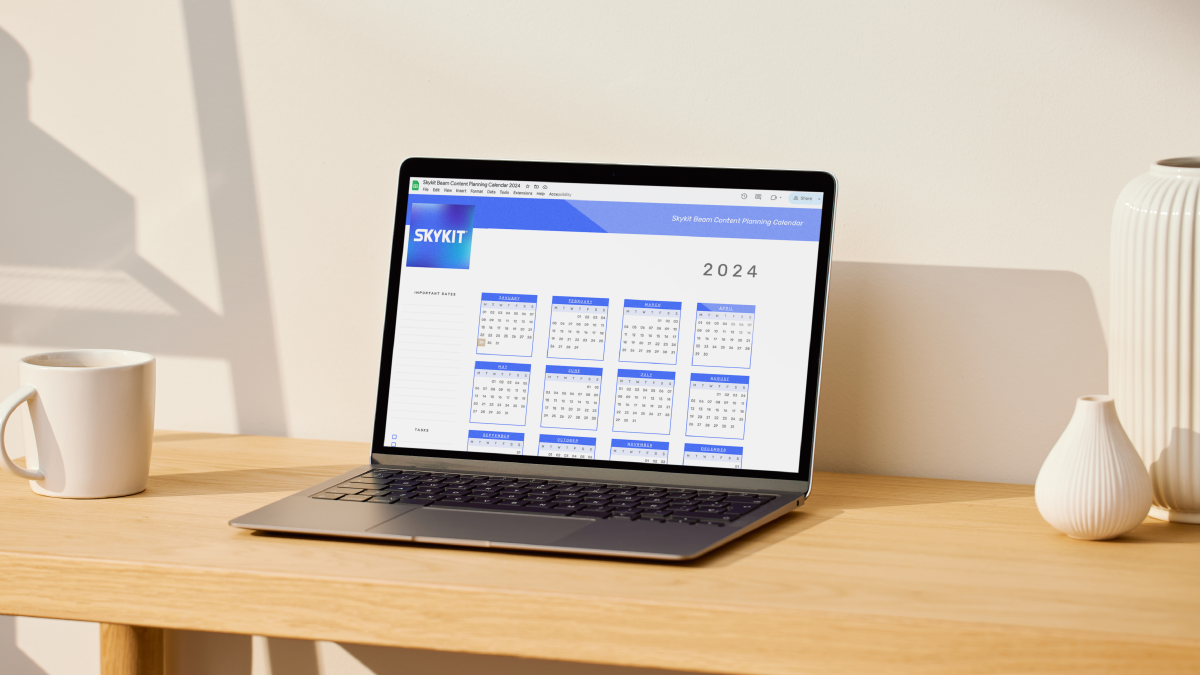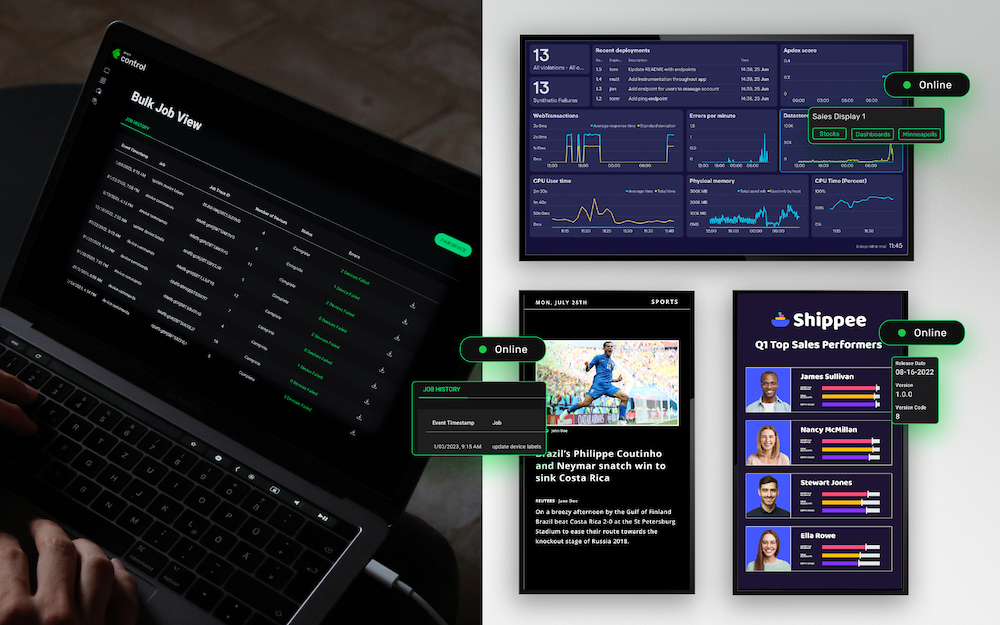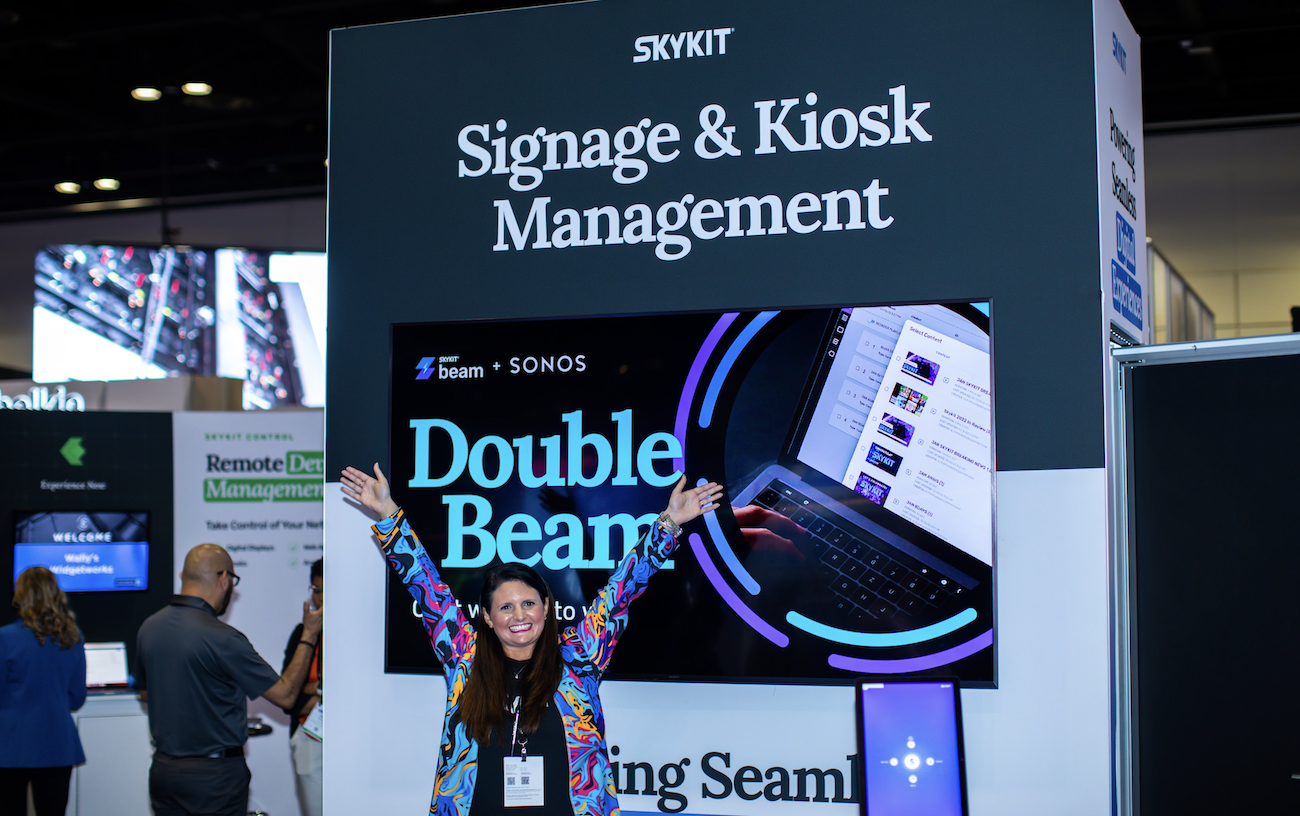Making the decision to use digital signage is one thing, but trying to figure out what kind of commercial screen you need to use is another.
There are so many questions to consider:
- What size screen do I need?
- Do I go with LCD or LED?
- Should it be interactive? Touch screen? Large? Small? Multi-paneled?
- Should it be tall? Round? Beveled?
- Should I start pulling my hair out now?
Yeah, we get it.
These are all great questions (including whether or not you should pull out all your hair), and we’ve decided to break those questions down and answer them based on four different industries that use digital signage the most.
After all, different industries have different needs, right? What works in one industry won’t necessarily work in another. So let’s get to it.
Here’s what to look for in a digital signage screen based on the top four industries that use them:
1) Retail
The retail industry probably uses more variations of digital signage screens than any other industry. We’ve seen basic wide screens, touch screens, kiosks, and interactive screens.
What to use, when, is completely dependent on what it is you’re trying to accomplish. Most of the time, the end goal for any user is an increase in sales. But for many retailers, branding and customer awareness may be at the forefront of this end goal.
LED or LCD?
Either or. It used to be that LED screens were used primarily outdoors, but the technology is changing and moving indoors.
If you plan on using a kiosk of sorts, those screens are typically LCD. If you plan on using an interactive screen, you can get a high-quality commercial screen as an LED or LCD.
Type of Screen?
For a basic retail or interactive campaign that shares video or images of sale items, a flat screen will work.
Size of Screen?
If you are doing a basic campaign in the middle of your retail shop, consider a flat screen that is at least a foot tall.
Mike White, CEO of Multi-Media Solutions, said in an interview with corporatetechdecisions.com that the basic visual guidelines for display readability are 1-to-6/1-to-8/1-to-10.
“Depending on the nature of the content,” he said, “your screen should be one foot tall for each six, eight or ten feet of viewing distance, meaning the furthest away you expect somebody to be reading or trying to absorb information from the screen.”
A Case Study
If you choose to go with an interactive campaign, consider what some retailers are doing with a 3D virtual dressing room. Also known as interactive mirrors or intelligent dressing rooms, these screens are changing the way we change.
Using hand and body gestures, a customer can try on clothes in front of a tall, commercial grade digital screen without ever stepping into the dressing room.
Sizes are determined by automatic user measurement.
UniQlo in San Francisco is using a version of the interactive “magic” mirrors with great success. The retailer unveiled their Sharp 60” digital display at the Digital Signage Expo in 2013.
Coupled with the display was a kiosk that allowed customers to choose the clothing they wanted to try on.
Who said digital signage wasn’t crazy versatile?
2) Education
The education sector, both collegiate and K-12, are using digital signage in ways that improve education, share knowledge, and guide students through the various roads and hallways of large campuses.
LED or LCD?
For regular viewing of information, LED screens are best.
For wayfinding, LED is the more popular choice.
LCD screens would be used for students using smaller devices in the classroom, like iPads or handheld touchscreens.
Type of Screen?
For regular viewing of information, a large flat screen is typical.
For wayfinding, a kiosk that is mounted or on a wall are most preferred.
Size of Screen?
For regular viewing of information, a large screen at the height of the viewer is ideal. For larger classrooms, go with larger screens. The standard size for a classroom is 76.”
For wayfinding, it depends on the location. Outdoor wayfinding screens are larger and placed centrally so they can be spotted easily. While they range in style, they typically are no smaller than 3.7” tall.
A Case Study
Thirteen signs at Western Tech Iowa Community College are bringing ease to students that need extra guidance. Located primarily at the entrances of each building, the signs not only act as digital maps, but also share classroom updates, events, and any changes in curriculum.
At Duke, students can click on the classroom they need and find the most efficient way to get there.
Lyle Bunn, a digital signage expert outside of Toronto said, “Unexpected construction in buildings or closure of pedestrian walkways [can] be input quickly into the wayfinding software and affected routes updated.”
Hundreds of large campuses all over the country are ditching paper maps and incorporating wayfinding systems instead.
3) Restaurant
These days, finding a QSR or fast casual restaurant that lacks digital signage in some form is unusual. More and more restaurants are adopting the digital method to encourage customer interaction and increase sales.
LED or LCD?
For tabletop and stand-alone kiosks, LCD screens are favored.
For large menu boards, LED boards are becoming more and more present.
Type of Screen?
For tabletop and stand-alone kiosks, smaller flat screens are used.
For large menu boards, tall, sometimes interactive screens are used.
Size of Screen?
For tabletop and stand-alone kiosks, the typical size used is the same size as a handheld tablet.
For larger, outdoor menu boards sizes most utilized are: Available in 46″, 57″,70″ and 82.”
A Case Study
Like the retail industry, the type of digital screen used depends on the purpose and drive of the campaign.
Pizza Hut chose a digital option that isn’t standard, but was chosen so the restaurant could go above and beyond standard digital signage practices.
In some restaurants, Pizza Hut uses a Microsoft PixelSense style touchscreen that is the table.
Customers sit down and right before their eyes is a table-sized touchscreen that allows them to design and order their pizza just the way they like it. A short time later their meal is delivered and set on that same table.
No worries. The digital aspects are protected. Tell me that isn’t wild.
4) Healthcare
The healthcare industry adopted digital signage early on, utilizing it in waiting rooms across the world. Now it’s showing up in the rooms of patients come breakfast, lunch, and dinner.
Hospitals are also using the technology to install interactive wayfinding screens to guide patients and their guests.
LED or LCD?
For waiting rooms of all sizes, one or more LED screens mounted at eye level are preferred.
For waiting rooms of all sizes, one or more LED screens mounted at eye level are preferred.
In hospital rooms, some patients are provided with an LCD tablet to order meals.
Wayfinding kiosks are typically LED.
Type of Screen?
For waiting rooms of all sizes, a flat screen is preferred.
In hospital rooms, a tablet.
Wayfinding kiosks vary but are usually small, mounted kiosks.
Size of Screen?
For waiting rooms of all sizes, the standard size is 76.”
In hospital rooms, the standard size is that of a handheld tablet.
Wayfinding kiosks vary but are often are no smaller than 3.7” tall.
A Case Study
Digital signs provide valuable education and information to patients.
Modern digital signage systems can integrate with patient records and other databases to display vital information within a patient’s room, replacing the traditional whiteboard.
Grandview Medical Center in Alabama has installed one such system.
In addition to entertainment and weather information, patients, their families, and their care providers can view information such as diet restrictions, upcoming tests, medical goals, and assessments.
Conclusion
Other industries that use digital signage include the transportation industry and the sports industry.
The most prime (and current) example of how digital signage is used during sporting events is the Olympics at Rio.
Not only did the massive event incorporate large commercial grade flat screens to post scores and boast videos of their champions, but they used a wayfinding system of more than 500 wayfinding signs to help guide visitors.
In airports across the globe, paneled digital signage displays are also guiding the way.
At the Dubai Airport in the United Arab Emirates, the massive campus has chosen to adopt green technology to illuminate their new wayfinding LED signage.
Thousands of signs have been installed in Terminal 3 alone, the exclusive Emirates terminal. By the time the project is completed, the LED wayfinding signs will be installed in every terminal throughout the airport.
Churches use digital signage.
Banks and other financial institutions use digital signage.
The corporate sector uses digital signage.
Every industry that understands the importance of digital communication is moving in the direction of digital marketing.
Aside from flat screens and kiosks, pillar screens and rounded, beveled screens are used. Go to New York City and you’ll see dozens of examples.
When it comes time to determine what you need, consider the questions we asked at the top:
What size do I need?
Do I go with LCD or LED?
Should it be interactive? Touch screen? Large? Small? Multi-paneled?
Should it be tall? Round? Beveled?
Should I start pulling my hair out now?
Only don’t pull out your hair. Especially because we just made this easy for you. If you want more information, or are wondering about an industry that is not included in this post, visit our website to learn more.
What kind of screen do you use in your digital marketing campaign?



